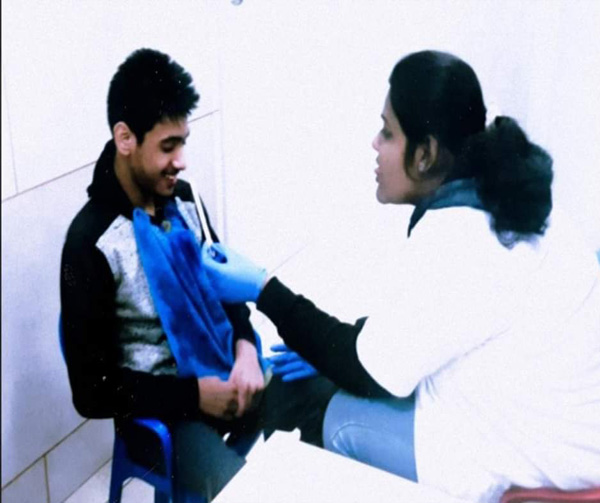 Children with neurodevelopmental disorders suffer from various types of communication difficulties, including deficits in both language and speech.
Children with neurodevelopmental disorders suffer from various types of communication difficulties, including deficits in both language and speech.
Language Disorders: Difficulty in acquiring and using language.
Speech Sound Disorders: Lack of phonological awareness of sounds.
Fluency Disorders: Disturbance in normal speech fluency.
Pragmatic Communication Disorders: Severe deficits in social communication and interaction.
A common long-term goal of speech-language therapy for children with neurodevelopmental disorders is to establish effective communication skills.
Depending on the child’s speech-language characteristics, the short-term goals of speech therapy could include:
If the child has a motor speech disorder (mainly dysarthria) due to impairments in coordination of phonation, respiration, resonance, and articulation, the following techniques can be used:
Oromotor and Proprioceptive: Neuromuscular facilitation (PNF) exercises of the oral cavity can be used to improve orofacial muscle tone and coordination of articulators, thereby improving speech intelligibility/clarity. These exercises also enhance oral sensory awareness, reduce drooling, and address tongue thrust issues.
Exercises may include:
- Oromotor exercises such as massaging the cheek muscles and muscles around the lips using fingers.
- PNF exercises such as massaging the inner oral cavity (inner cheeks, tongue) using a finger brush or vibrator brush (Z-vibe) to improve oral sensory awareness.
Blowing Exercises: Blowing candles, paper bits, bubbles, and whistles to train facial muscles to produce certain sounds and to enhance lung volume capacity, breath support, and control.
Breathing Exercises: Encourage abdominal breathing with inhalation and exhalation exercises to strengthen diaphragmatic muscles and improve breath support for speaking longer phrases.
Jaw Exercises: Use chewy tubes (knob-shaped, P and Q (XT)) to improve jaw mobility. Eating crunchy foods like apples and carrots also helps strengthen jaw muscles. Practice opening and closing the mouth using only jaw muscles while someone supports the chin.
Lip Exercises: Use a lollipop to practice squeezing lips around it for improved strength and closure. Pursing lips to "kiss" the lollipop helps increase lip extension.
Tongue Exercises: Strengthen the tongue by sticking it out and pushing it against a tongue depressor, ice cream stick, or spoon for several seconds at a time.
Articulation/Speech Sound Disorders:
To improve articulation skills, articulation therapy may involve using a mirror and phonetic placement techniques such as flashcards and word lists. Encourage the child to make specific sounds while watching themselves in the mirror to learn proper tongue placement within the oral cavity.
Language Disorders:
If the child has a language or communication disorder, the following short-term goals may be set:
To Improve Receptive and Expressive Language Skills:
For younger children, intensive early stimulation is key. This enhances their receptive vocabulary and encourages verbal communication.
Language and Word Association: Use flashcards or puzzle pieces with word pairs like toothbrush–toothpaste, comb–hair, shoes–socks, etc.
Improve Receptive Vocabulary: Identification of categories such as:
- Common objects (food, clothing, furniture, kitchen items)
- Lexical categories (fruits, animals, vegetables, vehicles)
- Verbs (eating, sitting, drinking, etc.)
- Adjectives (clean, dirty, big, small, etc.)
- Prepositions (up, down, beside, in front, between, etc.)
- Adverbs (fast, slow, etc.), along with other grammatical forms.
This is done using flashcards. Show the child pictures at eye level, then place two images in front and ask them to choose the correct one.
To Improve Expressive Language Skills:
- Use vocal play, such as animal sounds ("dog says bow-bow") and vehicle sounds ("car horn: peep-peep") to encourage speech.
- Improve speech imitation skills (ability to repeat sounds/words).
- Encourage the child to name family members using a small photo album (one picture per page).
Use flashcards or picture books to teach vocabulary and ask the child to name the items. First, allow them to imitate you, and later encourage spontaneous responses.
Once the child begins to express single words, gradually increase their Mean Length of Utterance (MLU) to two-word phrases, then longer phrases and complex sentences.
Advanced Language Skills: Improve skills like picture description, story retelling, story generation, and conversational speech using visual tools like charts and short story sequences.
A speech and language therapist plays a vital role in the development of children with neurological disorders. They help children communicate effectively, and also assist with breathing and swallowing challenges related to such disorders.

Ms. Garima
Speech Therapist